Lockheed Hudson, AM885, Kinnagh, Wexford, 1943
Nine old tattered pages are all that is contained in the Irish Army archive report on the crash of a British aircraft near Ballycullane in County Wexford, Ireland on the 16th of September 1943. Three airmen from the British and Canadian air forces lost their lives in this little known crash.
The authorities recorded that at about 15:15 on the afternoon of Saturday, the 16th September, an aircraft crashed into a field in the townland of Kinnagh. Local Gardai and members of the Local Defence Force (LDF) were first to the scene and they reported back to the Irish Army coastal fort at Duncannon. The owner of the field was one Moses O'Neill. Sadly, no aid could be brought to the occupants of the aircraft as it had been completely destroyed in the crash. The aircraft had been consumed by the post crash fire. The military party from the 1st Field Company based at Duncannon could do no more than gather up the wreckage and return it to the fort for disposal.
Before this however, those present had the sad task of
recovering from the wreckage the remains of those on board. Upon
arrival the Irish army party had immediately found the remains
of two men. Despite the fire which burned on into the evening,
these two bodies were recovered and another was then found under
the the aircraft. From these remains some letters were recovered
and it was possible to identify two of the airmen provisionally.
It was believed they were
R/131724 F/Sgt. Chabara, A.J.,, R.A.F.,
Lyneham
657975 Sgt. J. Colhoun, R.A.F., Station, Lyneham,
Wilts
Part of a typed report in the Irish Army file reads: "The number of the plane was given as
P.8825. It was a twin engined one and the Military Officer
who went to the scene thought it was a "Beaufighter".
"Afterwards I learned that it was a Hudson Bomber."
It is not made clear in the Irish Army report where the supposed
number P.8825 was being read or guessed from, the serial AM885
would would have been painted on the rear fuselage of the
aircraft but by all accounts this was burned out.
The report goes on to say: "The
Command O.C. [Officer Commanding] gave instructions that Officer quality
coffins should be procured and the bodies conveyed to the
Border on the 17th instant. Duncannon reported that they
would be procured in Waterford.
This report was sent by Commandant D Mackey of the G2, Army
Intelligence, Section in Curragh Command. He goes on in his
concluding paragraphs:
I had a phone call from Comdt. Quinn at
10.00 hrs. on the 17th inst. informing me that an Official
from the British Office would call to the Curragh later and
go to Duncannon and that he would probably send an officer
with him. The Officer from Baldonnel with the British
representative called to headquarters, Curragh at 13:15
hours and proceeded after an interview with me to Duncannon
Fort.
Capt. O'Toole proceeded with the bodies from Duncannon Fort
to Dundalk at 14.20 hrs. on the 17th inst. The adjutant,
Eastern Command was notified accordingly so that the
arrangements for handing over at the Border could be
completed.
It was also arranged that the handing over of personal
papers etc. would take place at the same time.
Further hand written notes in the file indicate that Capt. P. O'Sullivan and F.Lt Herbert S Moore of the RAF did visit the scene on the morning of the 17th of September. The remains of the aircraft were such that the Irish Air Corps indicated no interest in salvage and what could be removed was taken to Fort Duncannon for disposal. A nd thus the sad affair ended.
The aircraft had been recorded in the hour prior to the crash
flying around the south coast of Ireland and it was believed to
have been heard by Gardai at Skibbereen in Cork, flying south,
and then by the Irish Coastwatching Service Look Out Post (LOP)
at Toe Head, the Garda stations at Cobh and Whitegate flying
overland on the east coast of Cork Harbour, where they believed
it turned south and was next heard by the LOP's at Ballycotton
and Hook Head moving North East. Little mention is made of the
weather conditions in the filed reports and memo's from Irish
sources but it should be perhaps noted that the aircraft was
'heard' by the Gardai and Look Out Post personnel, rather than
sighted. In June 1945 following the end of the war, the local
Wexford newspaper, the New Ross Standard, ran a short article
about this crash and the loss of an Anson in the same year. This
article begins, "On Thursday, 16th
Sept., 1943, a day on which visibility was very bad, a
British aeroplane crashed at Kinnagh, in a field adjoining
the main Wexford-Duncannon road. There were three occupants
and all were killed."
It goes on to mention the names of the two men identified and
that the third man, who could not be named at the time, had
'objects of piety' in his possession which indicated he was
Catholic. An inquest was held by the Coroner for South Wexford,
Mr F M O'Connor with evidence from Capt. Coughlan of the Irish
Army and Dr. Toohill both from Duncannon. No reason for the mens
deaths could be arrived at by this civil court but it was
assumed that mechanical defect or fuel starvation caused the
crash. The three men were registered dead in the New Ross
registration district following this inquest, their names being
recorded as, 'J Male Colhoun'; 'A J (Male) Chaloner' and the
final member simply as 'Male'.
And so what of the three men, their names could finally be confirmed by the UK authorities and we can easily find their names now using the Commonwealth War Grave Commission website, www.cwgc.org. The crew consisted of a Scottish pilot, a Welsh navigator and a Canadian radio operator/ air gunner. Details of the crew can also be confirmed from the Royal Canadian Air Force service record of F/Sgt A J Chabara.
Among the records in F/Sgt Chabara service file are copies of telegrams sent in the immediate aftermath of the crash and an Air Ministry Form 765, 'Report on Flying Accident or Forced landing not attributable to enemy action'. These provide the background to the flight that ended so tragically in Kinnagh.
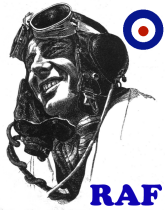 |
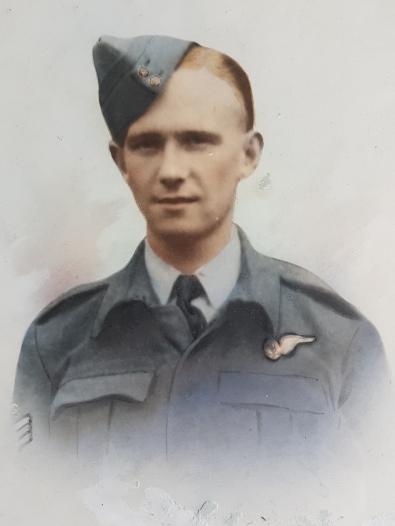 |
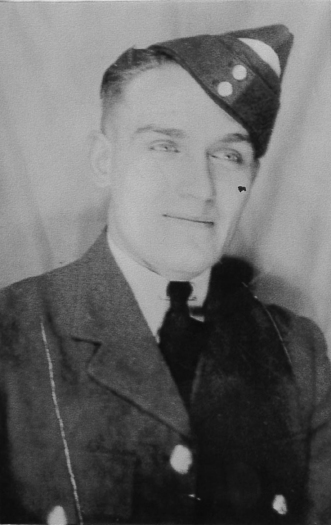 |
|
F/Sgt John COLHOUN 657975 +, Pilot |
F/Sgt Pryce OWEN 655407 + Navigator |
F/Sgt Alexander James CHABARRA R/131724 + RCAF |
 John
Colhoun came from Paisley in Scotland, the son of Patrick
and Margaret Theresa Colhoun. His remains were returned to his
parents and are buried in Paisley Hawkhead Cemetery. He had
attended Saint Mirins Academy pre-war and was a 1939 Graduate of
the University of Glasgow.
John
Colhoun came from Paisley in Scotland, the son of Patrick
and Margaret Theresa Colhoun. His remains were returned to his
parents and are buried in Paisley Hawkhead Cemetery. He had
attended Saint Mirins Academy pre-war and was a 1939 Graduate of
the University of Glasgow.
Little else is known about John. He is buried with his parents
in the plot in Paisley. He had at least four older
siblings, Sarah, Patrick, James and Francis and one older,
Michael. The last of these, Patrick and James both died in
1973 it seems. John Colhoun's grave was unmarked unmarked
until at least 2015, except for the family headstone which
commemorates his father, died 1932, and grand father, died
1925. John's mother passed away in 1940.
The Commonwealth War Graves Commission placed a memorial slab
on the grave sometime after November 2015.
 F/Sgt Pryce Owen was the third airman from
the crew. and the Navigator on the crew. He was the
man whose name could not be identified by the Irish authorities.
His parents were Sarah Ellen and Albert Richard Owen.
Pryce spent time in Canada training during late 1941 to early
1942, as evidenced by him having a RAF Ferry Command record
card, which shows him having crewed on the ferry flight of
Hudson III FH337 from Montreal to the UK on the 17 April 1942.
F/Sgt Pryce Owen was the third airman from
the crew. and the Navigator on the crew. He was the
man whose name could not be identified by the Irish authorities.
His parents were Sarah Ellen and Albert Richard Owen.
Pryce spent time in Canada training during late 1941 to early
1942, as evidenced by him having a RAF Ferry Command record
card, which shows him having crewed on the ferry flight of
Hudson III FH337 from Montreal to the UK on the 17 April 1942.
His father was described as an aircraft fitter in his sons
probate records. His remains were returned to his mother for
burial in the local Penygroes Cemetery, Llanllyfni, Caernarvon.
On September 24, 1943 the families local newspaper, the
Caernarfon and Denbigh Herald, published the following funeral
report for the young airman.
FLYING OFFICER'- Friday, the sad news
was received by his parents of the death of Flight Sergeant
Price Owen (R.A.F.), as the result of an accident on
September 16th.
Deceased, who was 23 years of age, was the son of Mr.
and Mrs. Albert Owen, 12. Maes Dulyn, Penygroes. He was
highly popular and was held in high esteem by his
fellow-airmen.
His untimely death will be grieved by all. Sympathy is
extended to the family in their sad bereavement. His
brother, Albert Richard, is with the R.A.F. in Canada. The
funeral took place on Thursday, 23rd September, interment
being at Macpelah Cemetery, Penygroes.
The family's grief was no doubt felt only days later when
Pryce's sister Sarah's wedding took place to Peter Farmer,
himself an RAF Aircraftman.
A local resident was kind enough to visit his grave in 2006 and
provided the words from the headstone inscription, which reads:
In Treasured memory of
our dear son
Flight Sergent Pryce Owen
12 Maes Dulyn Penygroes
who lost his life over Ireland
Sept 16 1943 aged 23 years
Only those who know are able to tell
How sad is the parting without a farewell
His father, Albert died in late 1949 following an accident at a
quarry at which he worked
A letter sent to Pryce's sister in 2006 was replied to by his
nephew, the late Judge M Farmer from Wales. He was aware of the
crash and told of a local man from Wexford who wrote to Sgt
Owen's family. Sadly, his nephew passed away before any further
information could be exchanged. Pryce's grand-niece
however very kindly provided a scan of his wartime portrait
which is found here. His sister Sarah kept the photo as a
treasured memorial to her lost brother.
Pryce had moved to London for work prior to his enlisting the RAF. A local Wexford man, Michael Power, wrote to the Owen family on June 24th, 1945 to say: His plane crashed into a field beside my house. I was the first on the spot. I saw immediately that the boys were past all human aid so that nothing could be done but just let the plane keep on burning, the bodies were all thrown from the plane by the shock of the crash and were not burned.
Pryce's name is recorded on the Penygroes town war memorial, with the spelling Price Owen.
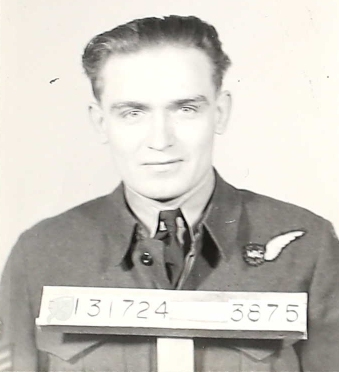
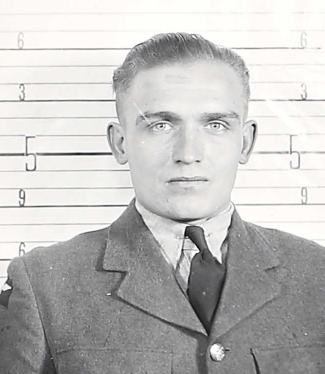 F/Sgt Alexander James CHABARA
was the final member of the crew of Hudson AM855. The son of
Nick and Rose Chabara, he came from Vilna, Alberta, Canada, a
small village founded only in 1907 during the building of the
railroads. He worked from 1935 to 1940 as a clerk and later
manager in a general store in East Coulee, Alberta. He enlisted
in the Air Force on 19 September 1941 and began his training
early in 1942 in Canada. He trained in No. 2 Wireless School in
Calgary and 7 Bombing and Gunnery School in Paulson, Manitoba.
He sailed to Europe in March 1943 and was posted to number 1
(Coastal) Operational Training Unit ((C)OTU) in June 1943. This
unit was based at RAF Thornaby in Yorkshire. The three airmen
may have formed a new training crew at this location and may
have been in training together to form a future frontline crew
together. His service file lists a posting dated 18th August
1943 to RAF Lyneham from 1 (C) OTU. A J Chabara was laid to rest
in the cemetery in Eglantine, County Down in Northern Ireland.
F/Sgt Alexander James CHABARA
was the final member of the crew of Hudson AM855. The son of
Nick and Rose Chabara, he came from Vilna, Alberta, Canada, a
small village founded only in 1907 during the building of the
railroads. He worked from 1935 to 1940 as a clerk and later
manager in a general store in East Coulee, Alberta. He enlisted
in the Air Force on 19 September 1941 and began his training
early in 1942 in Canada. He trained in No. 2 Wireless School in
Calgary and 7 Bombing and Gunnery School in Paulson, Manitoba.
He sailed to Europe in March 1943 and was posted to number 1
(Coastal) Operational Training Unit ((C)OTU) in June 1943. This
unit was based at RAF Thornaby in Yorkshire. The three airmen
may have formed a new training crew at this location and may
have been in training together to form a future frontline crew
together. His service file lists a posting dated 18th August
1943 to RAF Lyneham from 1 (C) OTU. A J Chabara was laid to rest
in the cemetery in Eglantine, County Down in Northern Ireland.
The documents relating to the crash in F/Sgt Chabara's file in
Canada indicate that the aircraft they were flying, a Lockheed
Hudson serial number AM885 was assigned to number 301 Ferry
Training Unit, based at RAF Lyneham in Wiltshire. RAF Lyneham
had become in 1943 a headquarters for RAF Transport Command and
an important center for the management of aircraft being sent
overseas to the Mediterranean for example. The reason for the
flight of AM885 on the 16th of September is listed as being a
non operational, daytime, consumption test. This mission type
points to the aircraft and crew preparing for a ferry flight
from the UK to perhaps Gibraltar in the weeks ahead.
Consumption tests were carried out by crews in preparation for
such flights to allow them get a good understanding of the way
their engines consumed fuel and operated.
By this stage in the war, the Lockheed Hudson had been largely
replaced as a front line aircraft in RAF Coastal Command for
patrols in the Atlantic. It was however used in the
Mediterranean extensively into 1944. It is possible that the
crew of AM885 might have been posted overseas had they not
crashed in Wexford.
Although born and raised at or near Vilna, Alberta, for a while
prior to joining the Air Force, Alexander worked in the
small mining community of East Coulee. When he died, East
Coulee claimed him as one of their own, and his name appears on
their cenotaph. Alex's neice provided this photo of the
memorial.
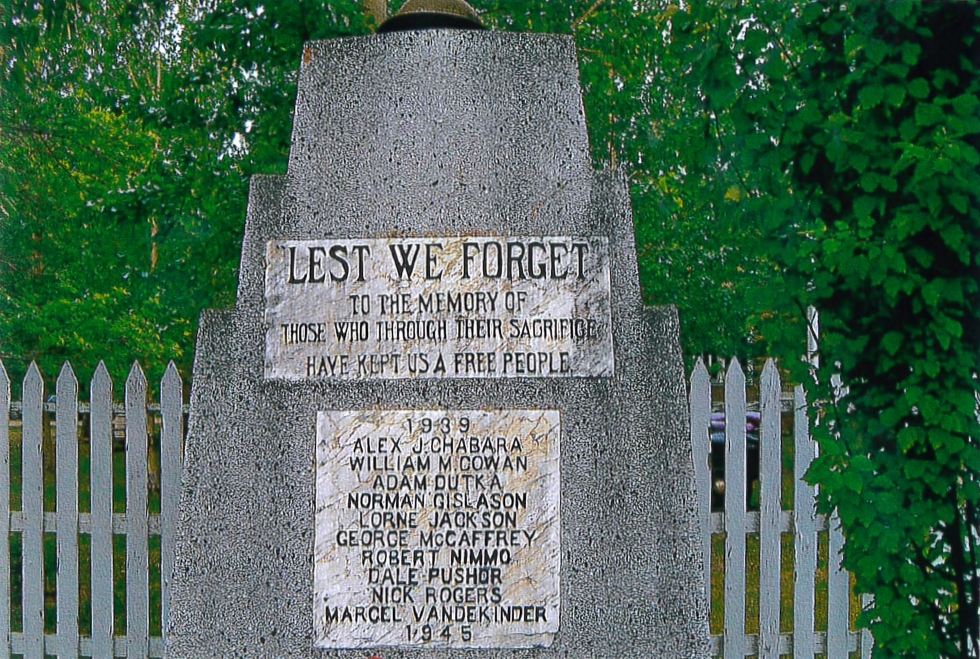
Due to the complete destruction of the aircraft and the fact that the crash occurred in neutral Irish territory, the contents of the RAF Form 765 for AM885 are extremely limited. Where one might normally find some piece of narrative in the Sections 10 to 13, one only finds the statements, 'None available - Pilot Killed', Not available - crash occurred in neutral territory' etc.
The location of the crash is shown in the maps and photos below. The Irish Army variously describe the location as Kinnagh and Ballycullane and to have been adjacent to the main road. During a visit to Kinnagh in August 2015, a call to some of the houses in Kinnagh resulted in meeting the Whelan family who currently own the field into which the aircraft crashed. The current owners assured me that the location was on the south east corner of the cross roads in Kinnagh townland between the road in Kinnagh and the main R733 road from Duncannon to Wellingtonbridge. The field is shown in the below screen grab from the OSI website, with the modern day field having been formed from about six older, smaller fields. I was told that despite the lack of any debris from the crash, if one was ploughing the field, traces of blackened soil is still evident.
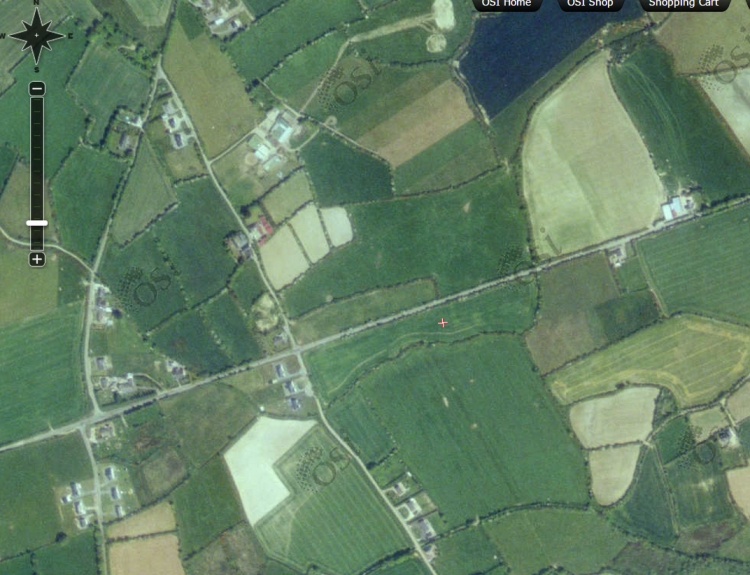
The field location shown on a map of the local area below.
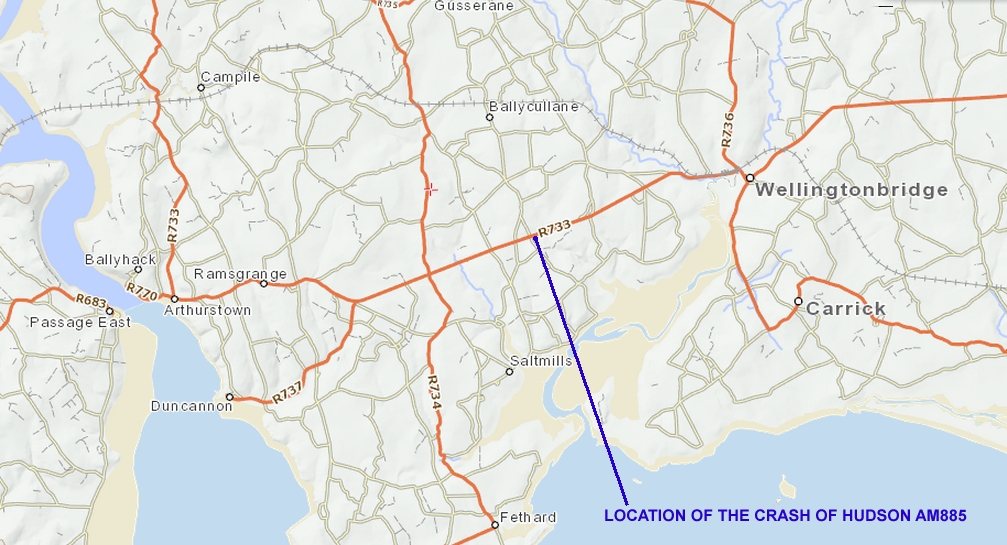
Below is a photograph of the field itself taken from the gateway.
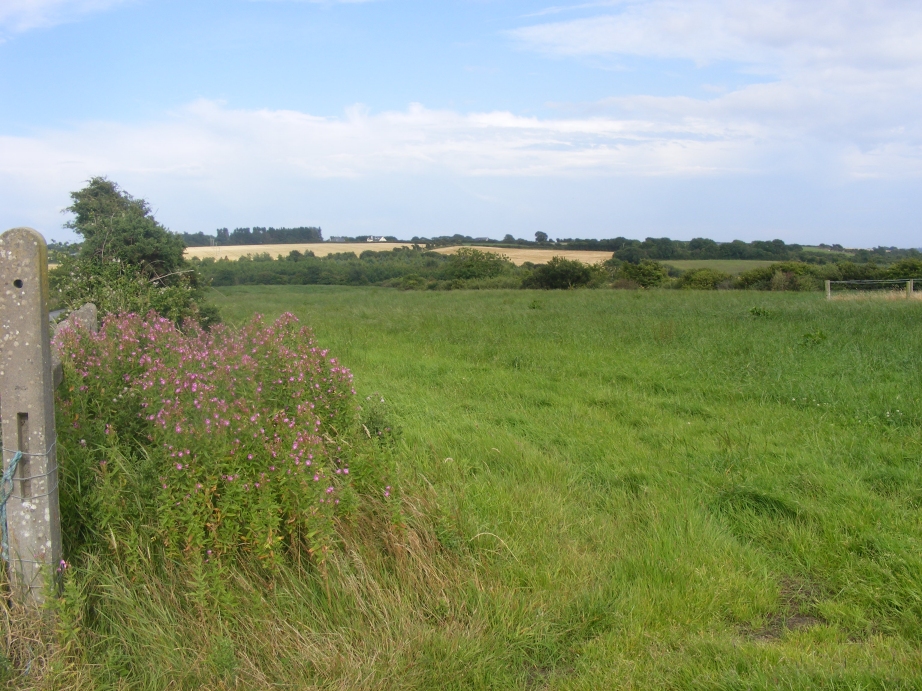
On the 15th September 2019, the community in Kinnagh,
Ballycullane unveiled a memorial stone at Kinnagh old cemetery
to the crew of AM885 and the other foreign airmen who died in
crashes in world war two in Wexford. All photos provided
by Sean Egan.
They also held a ceremony at the crash site, with piper leading
the assembled group from the cemetery to the crash site.
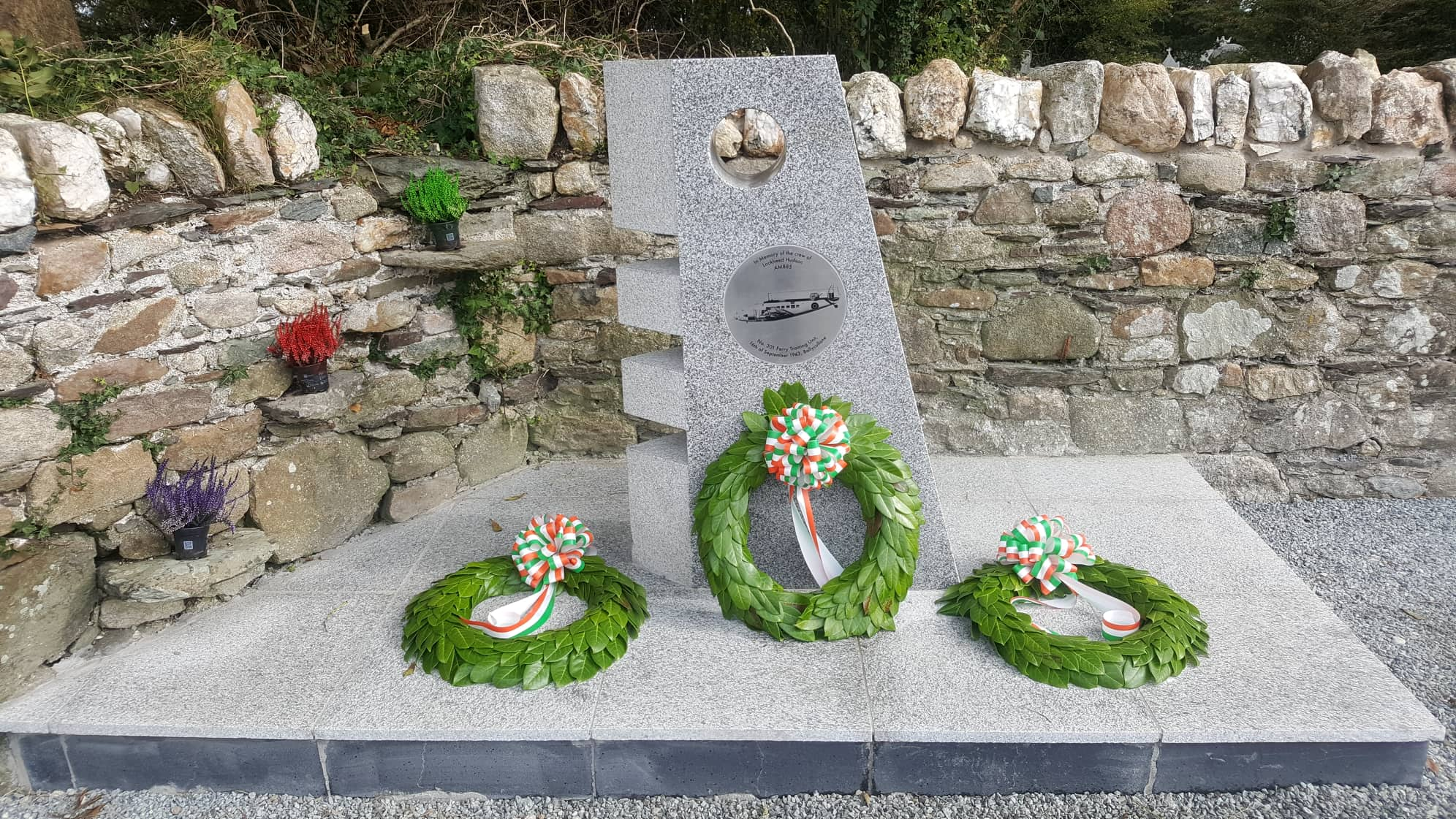
The granite stone design incorporates a swept back wing of an
aircraft. The hole in the top that of the crash site just half a
mile away. The circular plaque reflects an RAF Roundel. The
three cut sections at the rear represent the three lost lives
and also each country Canada, Scotland and Wales.
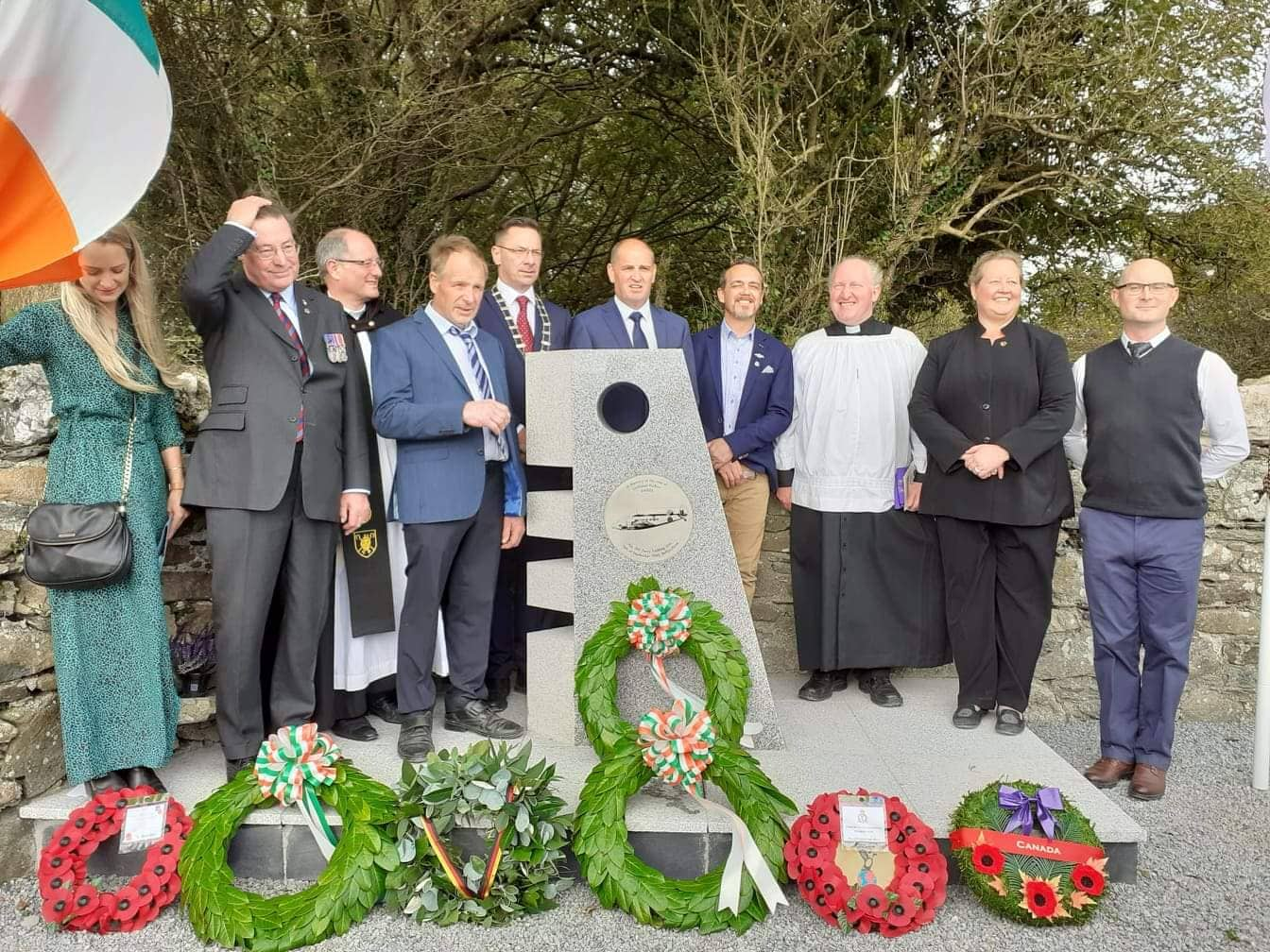
From left to right. Grace Downes (organiser), Roddy Bailey
(organiser and member of Royal British legion), Rev Canon Arthur
Minion (Church of Ireland), Billy Downes (organiser), Cllr
Michael Sheehan, New Ross; TD Minister Paul Kehoe, Sean Egan
(organiser), Father William Byrne, German Ambassador's
representative Nancy Reek and Graham Cadogan.
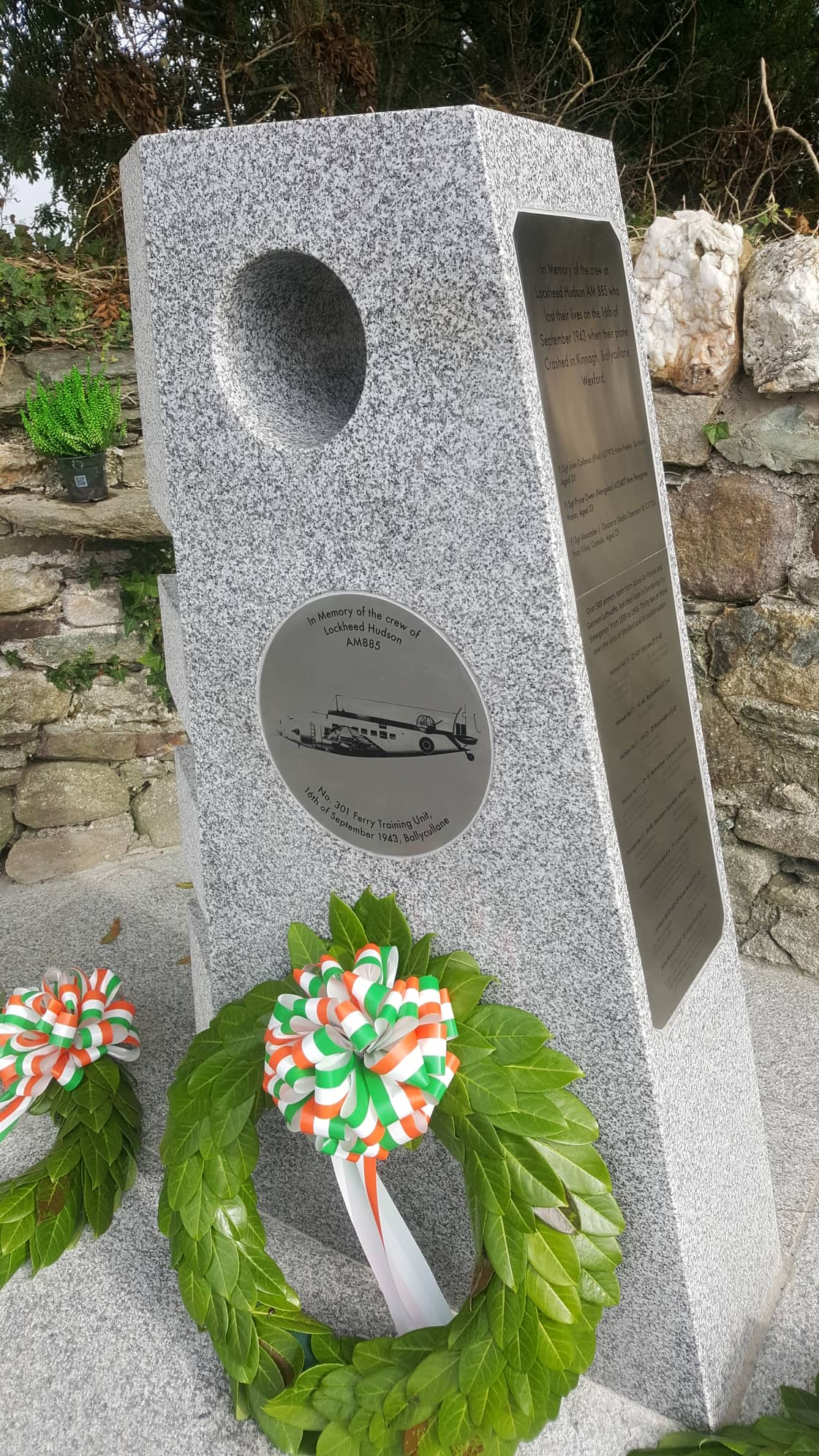
The aircraft was a Lockheed Hudson, carrying UK Air Ministry
serial number AM885. This was one of a batch of just over 200
Hudsons delivered too the RAF of the Hudson V (LR)
version. The aircraft's short but varied history is
recorded on its Air Ministry Form 78, and shows it many postings
with three different front line Squadrons but also long periods
with repair and maintenance organisations, but military and
civilian. The records for these do not provide a clear
picture as to the aircraft having suffered heavy damage on any
of these postings.
YYMMDD Unit or Station
410802 10 MU (Maintenance Unit)
410814 Lockheed S.A.S.
410903 24 MU
410904 59 Squadron
411208 48 Sqn SK???
411215 ROS (Repaired on Station)
420124 CRO (Civilian Repair Organisation)
420311 48 Squadron Wick
420623 53 Squadron
This posting is of particular interest as in July 1942 53
Squadron was posted to the Carribean for anti-submarine
duties. This is recorded in a book written by the
navigator of another aircraft, Reid Johnson of the Royal
Australian Air Force. Included in the book is a photo of
three of the squadron's aircraft taken during a stop over in
Greenland, with the tail of AM885 just jutting into the left of
the frame. The Squadron wartime diary shows AM885 was
coded PZ-G and was flown from the UK on July 7th, arriving in
Quonset, USA on the 19th. It departed there on the 3rd
August
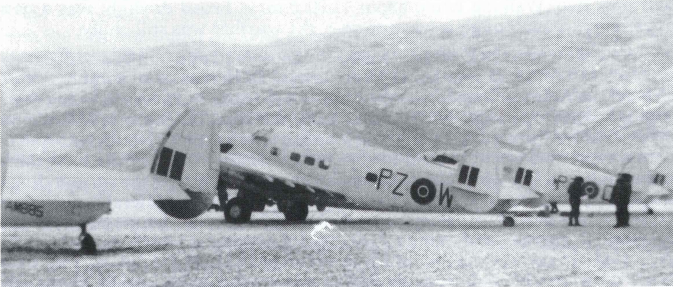
The unit was posted back to the UK in December and was
re-equiped during the spring of 1943 with Whitley
aircraft. AM885 arrived back in the UK on February 13th
before being posted out to 3502 SU per below.
430218 Gosport 3502 Servicing Unit
430303 53 Squadron
430305 Edzell RIW (Repair in works)
430318 Cunliffe Owen Edzell AW/CN
430322 22 MU
430521 Speke Mods
430608 29 MU
430812 Kemble
430902 301 FTU
430916 301 FTU CAT E FA
AM885 was the final of three Hudsons from this batch to end up
landing or crashing around neutral Ireland. AM834
crashed a year earlier of Wicklow and AM864
made an emergency landing in late 1941. A brief history of the
Hudson aircraft type can be read on Joe
Baugher's website. You can watch footage of a restored
example of the Hudson, based in Australia, at this Youtube
video:
